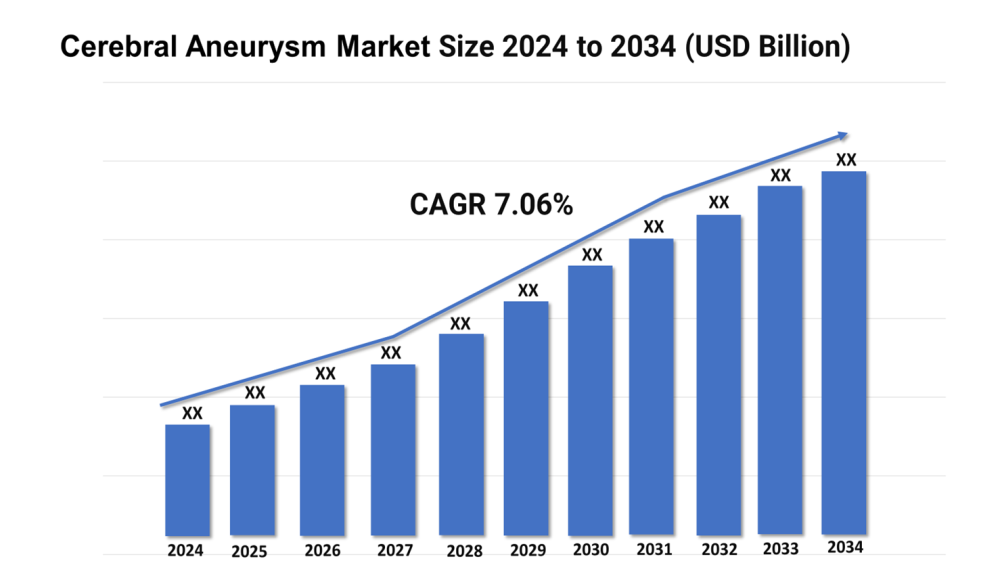Cerebral Aneurysm Market Outlook 2024-2034:
The cerebral aneurysm market is expected to reach a growth rate (CAGR) of 7.06% during 2024-2034. The market is driven by advancements in minimally invasive procedures, increased adoption of flow diverter stents, and rising awareness of early detection methods. Technological innovations, such as 3D imaging and AI-driven diagnostic tools, are enhancing treatment precision and patient outcomes, contributing to market expansion.
Advancements in Minimally Invasive Procedures: Driving the Cerebral Aneurysm Market
Advancements in minimally invasive procedures are revolutionizing the cerebral aneurysm market, offering significant improvements in patient outcomes and transforming the landscape of treatment options. One of the most prominent advancements is endovascular coiling. This procedure involves threading a catheter through the blood vessels to the site of the aneurysm and deploying coils to induce clotting, which seals off the aneurysm and prevents rupture. Endovascular coiling is associated with shorter hospital stays, less postoperative pain, and faster recovery compared to open surgery, making it a preferred choice for many patients and healthcare providers. Flow diverter stents represent another significant innovation in the field. These devices are placed within the parent blood vessel to divert blood flow away from the aneurysm, promoting natural healing and reducing the risk of rupture. Flow diverters are particularly beneficial for treating large or complex aneurysms that are difficult to manage with traditional coiling or clipping techniques. Their ability to provide a durable and less invasive solution has contributed to their growing adoption in clinical practice.
Request a PDF Sample Report: https://www.imarcgroup.com/cerebral-aneurys-market/requestsample
Technological advancements are also playing a crucial role in enhancing minimally invasive procedures. The integration of 3D imaging and high-resolution angiography allows for precise mapping of aneurysms and better planning of interventions. Furthermore, robotic-assisted surgeries are emerging as a promising approach, offering greater precision and control during complex endovascular procedures. The combination of these advancements is driving the cerebral aneurysm market forward. Patients benefit from safer, more effective treatments with reduced morbidity and mortality rates. As research and development continue to progress, it is expected that minimally invasive procedures will become even more refined, further solidifying their place as the standard of care for cerebral aneurysms. The ongoing evolution in this field underscores a commitment to improving patient outcomes and enhancing the quality of life for individuals affected by cerebral aneurysms.
Technological Innovations: Contributing to Market Expansion
Technological innovations are significantly shaping the cerebral aneurysm market, leading to transformative changes in diagnosis, treatment, and patient management. Cutting-edge advancements are enhancing the precision, safety, and effectiveness of interventions, thereby improving overall patient outcomes and expanding treatment options. One major technological breakthrough is the integration of high-resolution 3D imaging and advanced neuroimaging techniques. These technologies, such as 3D digital subtraction angiography (DSA) and magnetic resonance angiography (MRA), provide detailed, three-dimensional views of cerebral aneurysms and surrounding vasculature. This enhanced imaging capability allows for a more accurate assessment of aneurysm size, shape, and location, facilitating better planning and execution of treatment strategies. Another significant innovation is the development of advanced endovascular devices. New-generation flow diverter stents, embolic coils, and detachable balloons are designed with improved materials and technology, offering better performance and safety profiles. For instance, flow diverters made from advanced biomaterials are now more effective at managing complex aneurysms and minimizing complications. Additionally, the use of drug-eluting stents and coated coils has further improved treatment outcomes by reducing the risk of thrombosis and promoting better healing.
Robotic-assisted technology and AI-driven tools are also making a substantial impact. Robotic systems provide enhanced precision and control during endovascular procedures, while AI algorithms assist in automating image analysis, predicting aneurysm growth, and personalizing treatment plans. These innovations are streamlining workflows, reducing procedural times, and enhancing the accuracy of interventions. Furthermore, the development of wearable and remote monitoring devices allows for real-time patient monitoring and follow-up care. These technologies enable clinicians to track patient progress, detect complications early, and adjust treatments promptly, ensuring optimal management of cerebral aneurysms.
Increased Awareness and Early Detection:
Increased awareness and early detection are pivotal factors driving progress in the cerebral aneurysm market, fundamentally enhancing patient outcomes and treatment efficacy. As awareness campaigns and educational initiatives expand, more individuals are recognizing the risk factors and symptoms associated with cerebral aneurysms, leading to earlier diagnosis and intervention. Public awareness campaigns play a crucial role in highlighting the importance of recognizing warning signs such as severe headaches, vision problems, and neurological deficits. By educating the public and healthcare providers about these symptoms and the risks associated with cerebral aneurysms, these campaigns facilitate timely medical consultations and prompt imaging assessments. As a result, patients are more likely to seek medical attention before an aneurysm reaches a critical stage, thereby reducing the incidence of life-threatening ruptures. Additionally, advancements in screening and diagnostic technologies have significantly contributed to earlier detection. Modern neuroimaging techniques, such as high-resolution MRI and CTA, allow for the non-invasive detection of cerebral aneurysms at an asymptomatic stage. These imaging tools offer detailed views of the brain’s blood vessels, enabling the identification of aneurysms that may otherwise go unnoticed until they cause symptoms or complications.
The rise of genetic screening and risk assessment tools has also enhanced early detection efforts. For individuals with a family history of cerebral aneurysms or known genetic predispositions, personalized screening programs can identify at-risk individuals before symptoms develop. This proactive approach ensures that those most vulnerable to aneurysms receive regular monitoring and preventive care. Moreover, improved guidelines for routine screening in high-risk populations and the integration of predictive analytics into patient management are further strengthening early detection efforts. Predictive models that analyze patient data to identify potential aneurysm risks enable healthcare providers to implement preventive strategies and tailor treatment plans accordingly. Overall, increased awareness and early detection are crucial in the cerebral aneurysm market, leading to more effective management and improved patient outcomes.
Buy Full Report: https://www.imarcgroup.com/checkout?id=8554&method=587
Leading Companies in the Cerebral Aneurysm Market:
The market research report by IMARC encompasses a comprehensive analysis of the competitive landscape in the market. Across the global cerebral aneurysm market, several notable companies are enhancing knowledge about cerebral aneurysms, their risk factors, and symptoms. Increased awareness is leading to higher rates of early diagnosis and intervention, which can improve patient outcomes and reduce the incidence of aneurysm-related complications. Medtronic and Cerenovus have been investing heavily in their manufacturing capacities in recent months.
Medtronic announced the launch of its next-generation flow diverter stent, the Pipeline Flex with Shield Technology. This device incorporates advanced coating technology designed to enhance aneurysm occlusion and reduce the risk of thromboembolic events. The new stent aims to improve patient outcomes for complex aneurysm cases.
Apart from this, Cerenovus received FDA approval for its Embolic Coil System. This system features a new coil design that allows for better placement accuracy and faster deployment, enhancing the efficacy of endovascular coiling procedures for cerebral aneurysms.
In February 2024, Stryker announced the release of its Neuroform Atlas Stent System. This stent system is designed for the treatment of cerebral aneurysms with an innovative design that offers improved deliverability and flexibility, making it suitable for challenging aneurysm anatomies.
Request for customization: https://www.imarcgroup.com/request?type=report&id=8554&flag=E
Regional Analysis:
The major markets for cerebral aneurysm include the United States, Germany, France, the United Kingdom, Italy, Spain, and Japan. According to projections by IMARC, the United States has the largest patient pool for cerebral aneurysm while also representing the biggest market for its treatment. This can be attributed to the rising emphasis on personalized approaches to treatment, driven by advancements in genetic research and risk assessment tools.
Moreover, there is a notable shift towards advanced, minimally invasive treatments. Innovations such as flow diverter stents, neurovascular embolization devices, and advanced endovascular techniques are improving outcomes and reducing recovery times. These technologies allow for more precise and effective treatment of cerebral aneurysms, contributing to their growing adoption in clinical practice.
Apart from this, growing awareness and advancements in imaging technologies are driving a trend towards earlier detection of cerebral aneurysms. High-resolution imaging modalities, such as 3D DSA and MRA, are being increasingly utilized to identify aneurysms at an asymptomatic stage, enabling timely and proactive treatment.
Key information covered in the report.
Base Year: 2023
Historical Period: 2018-2023
Market Forecast: 2024-2034
Countries Covered
- United States
- Germany
- France
- United Kingdom
- Italy
- Spain
- Japan
Analysis Covered Across Each Country
- Historical, current, and future epidemiology scenario
- Historical, current, and future performance of the cerebral aneurysm market
- Historical, current, and future performance of various therapeutic categories in the market
- Sales of various drugs across the cerebral aneurysm market
- Reimbursement scenario in the market
- In-market and pipeline drugs
Competitive Landscape:
This report offers a comprehensive analysis of current myasthenia gravis marketed drugs and late-stage pipeline drugs.
In-Market Drugs
- Drug Overview
- Mechanism of Action
- Regulatory Status
- Clinical Trial Results
- Drug Uptake and Market Performance
Late-Stage Pipeline Drugs
- Drug Overview
- Mechanism of Action
- Regulatory Status
- Clinical Trial Results
- Drug Uptake and Market Performance
Ask Our Expert & Browse Full Report with TOC & List of Figure: https://www.imarcgroup.com/cerebral-aneurys-market
IMARC Group Offer Other Reports:
eHealth Market: The ehealth market size reached US$ 120.7 Billion in 2023, and projected to reach US$ 505.9 Billion by 2032, exhibiting a growth rate (CAGR) of 16.7% during the forecast period from 2024 to 2032.
Healthcare Staffing Market: The global healthcare staffing market size reached US$ 41.8 Billion in 2023, and projected to reach US$ 69.1 Billion by 2032, exhibiting a growth rate (CAGR) of 5.6% during the forecast period from 2024 to 2032.
Healthcare IT Market: The global healthcare IT market size reached US$ 327.9 Billion in 2023, and projected to reach US$ 843.7 Billion by 2032, exhibiting a growth rate (CAGR) of 10.7% during the forecast period from 2024 to 2032.
Transdermal Drug Delivery Systems Market: The global transdermal drug delivery systems market size reached US$ 6.7 Billion in 2023, and projected to reach US$ 11.1 Billion by 2032, exhibiting a growth rate (CAGR) of 5.5% during the forecast period from 2024 to 2032.
Antifungal Drugs Market: The global antifungal drugs market size reached US$ 15.1 Billion in 2023, and projected to reach US$ 20.1 Billion by 2032, exhibiting a growth rate (CAGR) of 3.1% during the forecast period from 2024 to 2032.
Precision Medicine Market: The global precision medicine market size reached US$ 75.2 Billion in 2023, and projected to reach US$ 168.3 Billion by 2032, exhibiting a growth rate (CAGR) of 9.1% during the forecast period from 2024 to 2032.
Medical Tapes and Bandages Market: The global medical tapes and bandages market size is expected to exhibit a growth rate (CAGR) of 3.29% during the forecast period from 2024 to 2032.
Contact US
IMARC Group
134 N 4th St. Brooklyn, NY 11249, USA
Email: Sales@imarcgroup.com
Tel No:(D) +91 120 433 0800
Phone Number: - +1 631 791 1145, +91-120-433-0800


